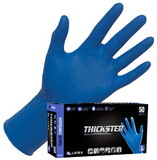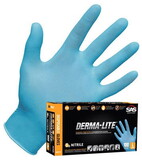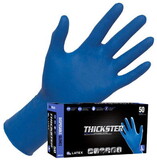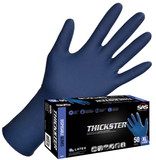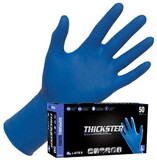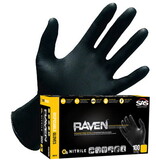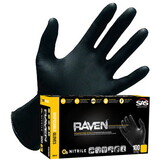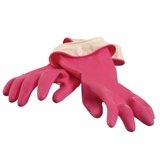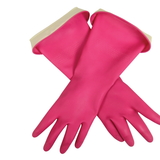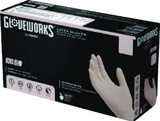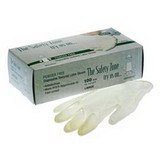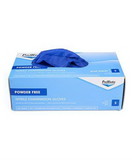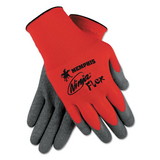SAS Safety Corp 6605-20 Latex Thickster Pf Exam Grade Xxl, Price/BX
* Click "Add to Cart" to calculate shipping and delivery time.
Product Description
Price is for BX.
- Disposable Gloves
- Type Disposable
- Size 2X-Large
- Overall Length 12 Inch
- Material Powder-Free Latex
- Cuff Type Beaded
- Finish Textured
- Application Janitorial, Marine, Plumbing, Painting, Automotive
- Applicable Standard Iso 9001
- Thickness 14 Mil
"Backed By Its Name, The Thickster Provides Extreme Durability And Dexterity With Its 14 Mil Thickness. Made With A 12" Length For Added Protection, This Glove Comes In Handy For Janitorial, Marine, Plumbing, Painting And Automotive Uses."
Features / Benefits
- Powder-free exam grade latex
- Beaded cuff for easy donning
- Fully textured for superior grip
- Strong yet soft and flexible
- Single use only
Part Number: 6605-20
UNSPSC: 46181504
Specification
| Order Part Number | SA6605-20 |
| Item Desc | LATEX Thickster PF Exam Grade XXL |
| MANUFACTURER LONG NAME | SAS Safety Corp. |
| ADDITIONAL INFORMATION | Thickness 14 Mil |
| MANUFACTURER PART NUMBER | 6605-20 |
| Product Group Id | SA00 |
| Country of Origin | MY |
| Harmonization Code | 40111010 |
| Bin Code | FG203 |
| Default Selling Unit | BX |
| Catalog Pages(s) |
 Attention CA Residents: Prop 65 Warning
Attention CA Residents: Prop 65 Warning
 WARNING:
This product can expose you to chemicals which are known to the State of California to cause cancer, birth defects, or other reproductive harm. For more information, go to www.p65warnings.ca.gov.
WARNING:
This product can expose you to chemicals which are known to the State of California to cause cancer, birth defects, or other reproductive harm. For more information, go to www.p65warnings.ca.gov.
Product Warranty
Most Air and Power tools have a 90 days to one year warranty. Hand Tools are usually lifetime-abuse voids warranty.
Return Policy
The wearable safety items, like golves, masks, respirators, etc, are non-returnable.
Need more information?
Our staff are available to answer any questions you may have about this item
Our staff are available to answer any questions you may have about this item
Look Similar Items By Category
Customer Reviews
By John
Date: February 09, 2025
Hands down the best gloves a Plumber can have on his truck. The first time I bought these gloves was off a Snap On truck at a mechanic shop and they're great. Most so-called "thick" gloves bought at HomeDepot or Lowes will tear while putting them on but not these. If I'm not dealing with anything too nasty I can wear one pair for a whole week.
Rating:  [5 of 5 Stars!]
[5 of 5 Stars!]
 [5 of 5 Stars!]
[5 of 5 Stars!]
By Definitely Not A Robot
Date: January 10, 2025
These are insanely tough. I have tried so many gloves over the years, and I had just accepted that gloves break while in use. I saw these recommended by a mechanic friend who stated he can wear these for an entire day at his shop. Thinking "yeah, right" I decided to give them a go, and my flabbers are ghasted. I am doing a full refresh of an old truck of mine and I've literally worn thes ame pair of gloves for three days of work on the thing. Grabbing sharp edges of stuff, and pulling on parts. I finally got one finger stuck under a timing belt as I was installing it, and when I pulled the finger back, it put a very small pinhole in it, then I finished the rest of the job without the hole growing. Three days! That is insane. I never thought it was possible. I will literally buy these for as long as they make them. I am 100 sold.
Rating:  [5 of 5 Stars!]
[5 of 5 Stars!]
 [5 of 5 Stars!]
[5 of 5 Stars!]
By Eilyn excelente producto
Date: December 21, 2024
Me gustaron son resistentes
Rating:  [5 of 5 Stars!]
[5 of 5 Stars!]
 [5 of 5 Stars!]
[5 of 5 Stars!]
By Trevor Hodson
Date: December 06, 2024
I wish they were a little cheaper but they do Last.
Rating:  [5 of 5 Stars!]
[5 of 5 Stars!]
 [5 of 5 Stars!]
[5 of 5 Stars!]
By misheel
Date: November 29, 2024
The best glove I have ever used.
Rating:  [5 of 5 Stars!]
[5 of 5 Stars!]
 [5 of 5 Stars!]
[5 of 5 Stars!]
By Margaret and Jim
Date: November 15, 2024
We are beekeepers, and we’ve had quite a journey into “how to protect our hands” and “how to prevent cross-pheromone contact from one hive to another” and “how to keep cross-pheromone contact from one hive inspection to another with the same hive.” In addition, we often deal with chemicals (like working on car maintenance, automotive finishes, and deep-cleaning things at home. We are musicians, and our hands are important to us: so, these gloves are an essential bit of kit for many things we do! They’re great for so many reasons. Both of us find the leather/suede beekeeper gloves to be non-tactile and difficult to use for any tasks which need fine touch (handling the Queen, adding and removing components from the woodenware, dealing with lots of direct handling of our bees, etc.). We started out with leather gloves and went straight to nitrile gloves. For the most part, we used the inexpensive ones with which to start. They tore VERY easily, the bees sting right through them with only the slightest effort, they “sweated off from our hands” very quickly and so much more. Not a good thing. We finally worked our way up to the 14 mil Thickster gloves. In our case, the gloves last all day when handling cleaners and oils. No matter how hot or how cold the days are, these gloves are really resilient and strong during honeybee hive inspections. In addition, when the bees get “spicy” or downright “grumpy,” the gloves make the stings much less often, much less deeply inserted, and much easier to remove without squishing the venom sac. I get stung pretty much every inspection (at least once) and these gloves make the stings MUCH less invasive. NOTE: I would NOT say that the gloves PREVENT stings from occurring on my hands: they just make the stings less invasive.
Rating:  [5 of 5 Stars!]
[5 of 5 Stars!]
 [5 of 5 Stars!]
[5 of 5 Stars!]







